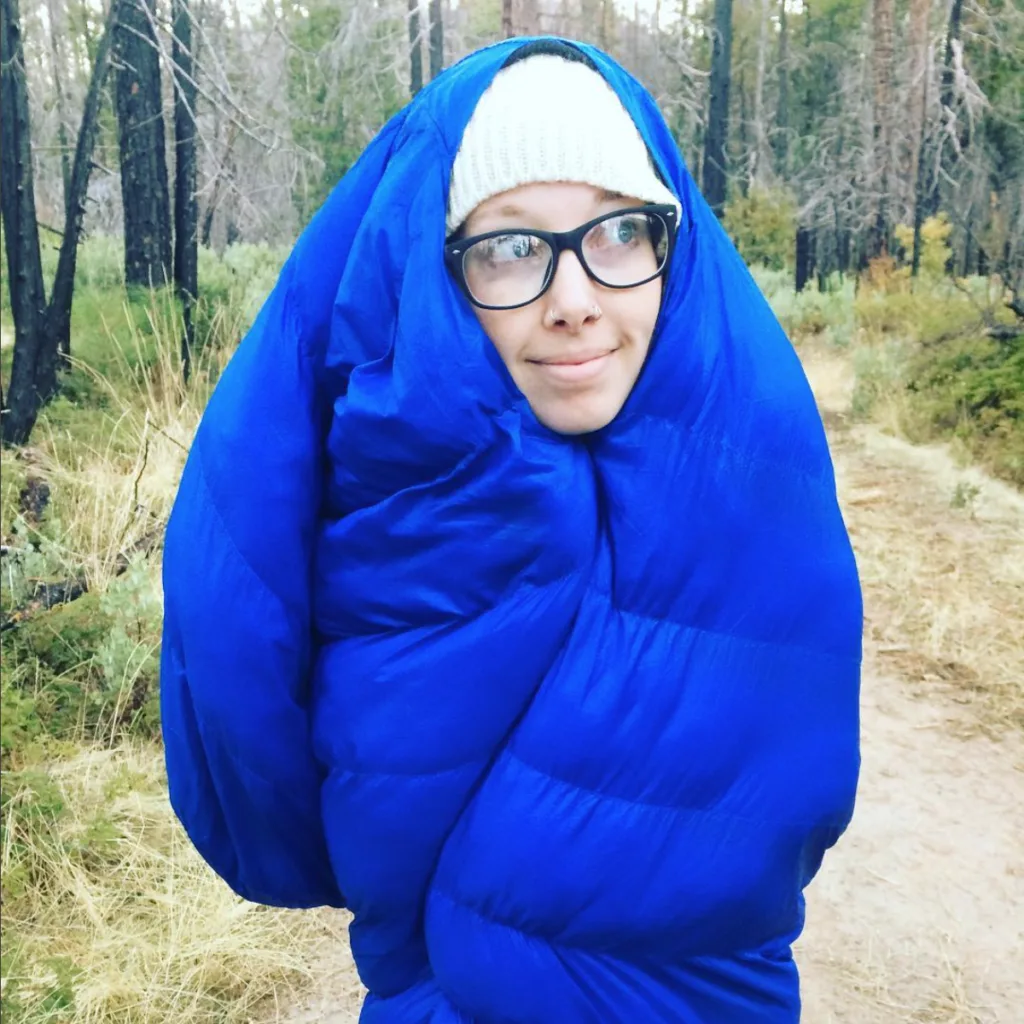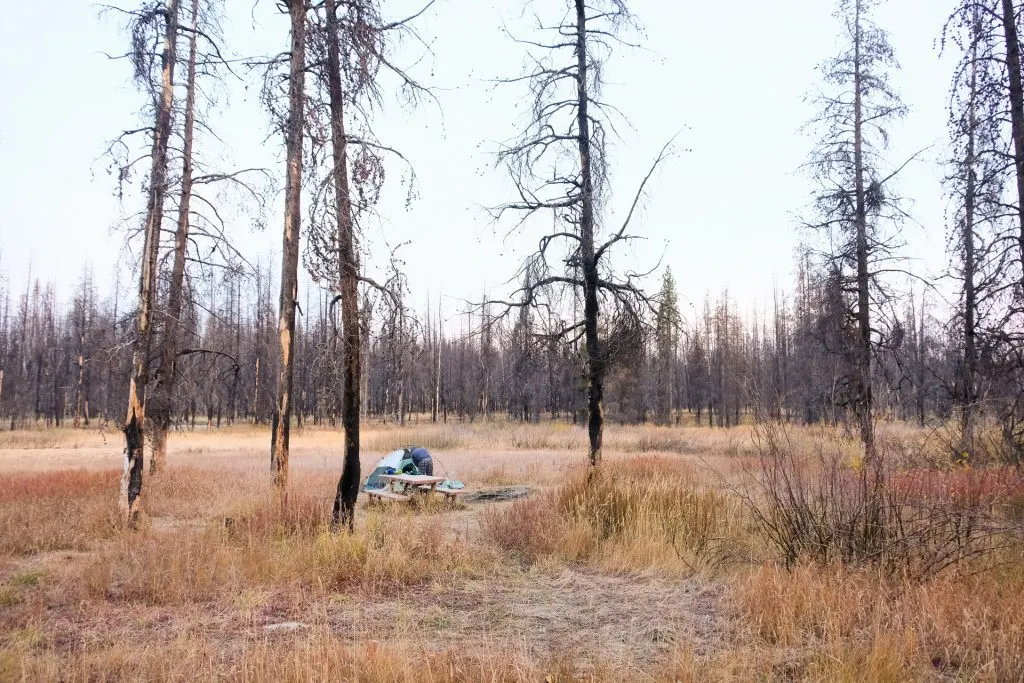The Terradrift giveaway is on! Enter here for a chance to win over $1,000 in outdoor gear!

If you’re new to winter camping or are thinking about giving it a go, I would be willing to bet the reason you haven’t tried it already has a lot to do with one thing: the cold. Ima be honest, that’s what has kept me from doing much winter backpacking or camping in the past. I’m a tiny person with no built-in insulation and I get cold quickly and completely. But now that it’s winter camping season, I’m ready to get out there and play on the empty trails with just the landscape and the wildlife. If you think you might just be ready, too, here are some tips on how to stay warm while winter camping.

10 Tips on How to Stay Warm While Winter Camping
1. Dress in layers
Don’t just grab one warm layer, put on several lighter ones. Select a snug base-layer that will wick moisture from your skin, then add a mid-layer like a synthetic zip-up, and if you’re really worried about being cold, maybe a light insulated jacket or vest under a waterproof jacket or coat.
If you start getting warm, be proactive about shedding layers before you get too sweaty or your brain might have trouble regulating your body temp (I’m cold, wait, I’m warm, wait, I’m wet, wait, I’m cold again…?). Then, as soon as you start feeling a chill, put those layers back on.
And don’t forget to layer those extremities. Wear thin gloves under thick gloves or mittens and thin synthetic socks under nice thick warm ones. Wear a scarf or balaclava under your hat. After all, it’s your fingers and toes that will likely be the first to feel the cold, so protect them.
2. Pack Handwarmers
You know those little single-use doohickies that you take out of the plastic packaging and they instantly get warm for 8 hours or something like that? Get some. We don’t normally like to recommend single-use products packed in plastic, but sometimes you do what you gotta do. There are a few battery-powered options out there (though they are often heavy and bulky), so that’s an option if you prefer something like that to disposable handwarmers. But they go a long way toward helping you stay warm while winter camping.
3. Stick with Synthetics
That means no cotton. NO. COTTON. Do I need to say it again? nocottonnocottonnocotton. This is a great general rule for any sort of prolonged outdoor activity, but it’s especially important in the winter when sweat, snow, and moisture are everywhere. Because cotton doesn’t dry. If it gets even slightly damp, it could take hours of airing it out in the sun, but if it’s cold and cloudy, it might never dry, and wet clothes mean you’re at a higher risk of hypothermia or frostbite. At the very least, you’ll just be really uncomfortable and cold, which is also not ideal.
So select clothing that is fully synthetic. We don’t recommend down (especially in wet winter conditions as it’s useless when wet) or wool here at Terradrift, but we love synthetic fleece, polyester, nylon, spandex, you name it.
4. Eat Up
Calories = Energy. Energy = Heat. Heat = Good. So pick high-calorie foods and snacks and eat them throughout the day, especially before you go to bed or if you wake up shivering. Turns out, the temp of the food doesn’t matter as much as the calories, so start cramming in the peanut butter!
5. Fill a Nalgene with Hot Water
Before you go to bed, heat up some water on the stove and pour it into a Nalgene or similar water bottle. Make sure that lid is on tight so the pressure from the heat doesn’t spray all over and get your gear wet when it gets sloshed around a little, then toss it into your sleeping bag to warm it up for you and help keep you toasty for those first few hours.
6. Keep Gear and Clothing Dry
All of it. At all times. Stuff doesn’t dry out in the winter as it does during the rest of the year when the sun is shining, temps are warmer and days are longer; if your stuff gets wet in the winter, it’s likely to stay that way. So protect it from moisture at all costs. That goes for the clothing you’re wearing, too. Opt for waterproof (or at least water-resistant) pants and jackets, use gaiters to keep the snow out of your boots, and waterproof gloves to keep those delicate hands warm and dry. If you can do that, you’ll be golden. Pack it all in dry bags or waterproof stuff sacks and wear waterproof gaiters over your boots.
7. Use the Right Gear
The “right” gear probably includes insulated waterproof hiking boots, a four-season tent, a sleeping bag rated for temps below freezing, a sleeping pad with an R-value of at least 4, and really warm clothes. Lots of them.
But if you don’t already have that stuff, there are alternatives: wear waterproof hiking boots and thick socks, utilize a free-standing 3-season tent, use a warm sleeping bag and a bag liner or backpacking quilt, stack a regular inflatable sleeping pad and an insulated foam pad, and wear really warm clothes. Lots of them.
Insulated boots will probably be warmer, but as long as they’re waterproof and you have thick, insulating socks that don’t make your boots too tight (tight boots inhibit circulation), you’ll probably be OK. Three-season tents, as long as they are free-standing (meaning they hold their shape without having to be staked down), are usually just fine. And while a sleeping bag rated for the temps you’ll be experiencing is ideal, layering the bag you already have with a liner (like these) or draping a backpacking quilt will do the job, too. And if you don’t have an insulated inflatable sleeping pad, just toss one of these (relatively inexpensive) closed-cell foam pads underneath to keep you insulated from the ground.
8. Don’t Hold it
Apparently, being cold doesn’t just make you feel like you have to pee more, having to pee makes you colder. So if you wake up in the middle of the night and have to go, just do it. If you can’t bear the thought of getting out of your tent because it’s freezing out there, carry a pee bottle or sealable container for the express purpose of relieving yourself into. You can try to do so without leaving your sleeping bag, but unless you’re 100% positive you won’t spill any (thus sullying your gear and stinking up the tent), just climb out for the two minutes it takes to pee. Ladies, if you want some assistance in this area, check out this post.
9. Stash your Boots in your Bag
If your boots have removable liners, remove them and stash them in the bottom of your sleeping bag overnight. Put them in a zip-top bag or dry sack if they’re damp. This will keep them from freezing if they’re damp and provide a toasty place to stuff your feet when you get up in the morning if they’re not. If your boots don’t have liners, bag the boots and stuff them down there, instead.
10. Bring a Space Blanket
Most often used for emergencies, these crinkly sheets of reflective material can certainly help you stay warm while winter camping. But don’t wrap yourself up in it unless absolutely necessary (you won’t sleep just because of how loud every movement will be). Instead, affix it to the ceiling of your tent so it can reflect heat back to you. This can also help block the cold if you’re making a three-season tent work that might have some mesh on the ceiling or sides.
There you have it. Ten tips on how to stay warm while winter camping. So don’t let a little cold and snow keep you from going outside! Get out there and wander on! And feel free to share your own tips for keeping the shivers at bay in the comments below!
*This post contains affiliate links, which means we might receive a teeny percentage of sales that result from you clicking on the above links. Which means we might be able to spring for a sleeping bag liner of our own!
Alisha is a freelance outdoor journalist and photographer based in Ogden, UT. She loves backpacking, hiking, mountain biking, kayaking and snowboarding (even though she’s terrible at it). She’s also pretty sure she’s addicted to coffee. alishamcdarris.com
